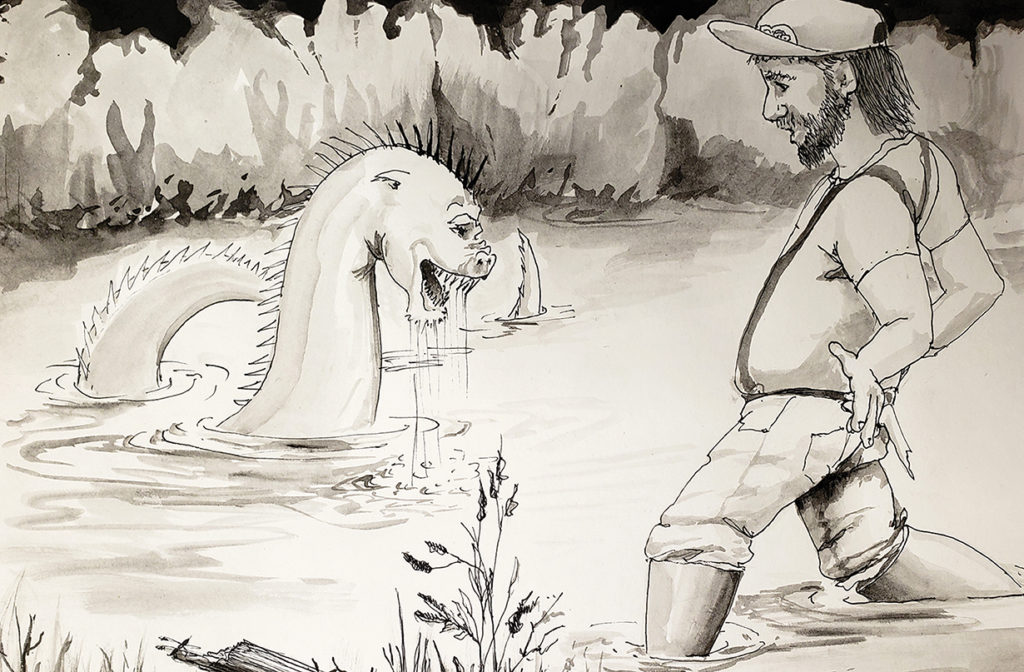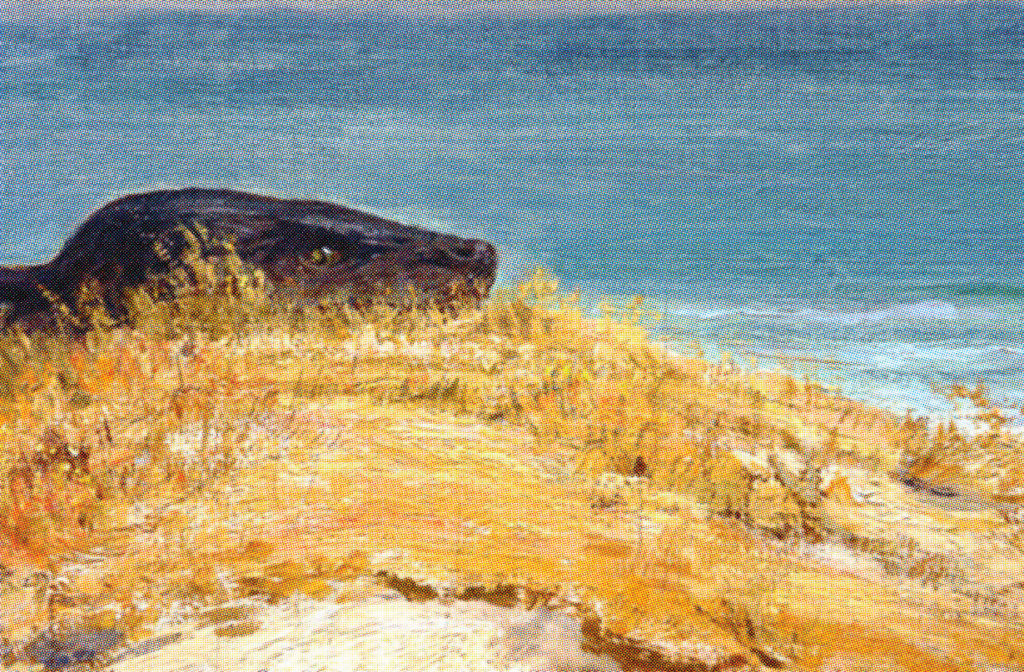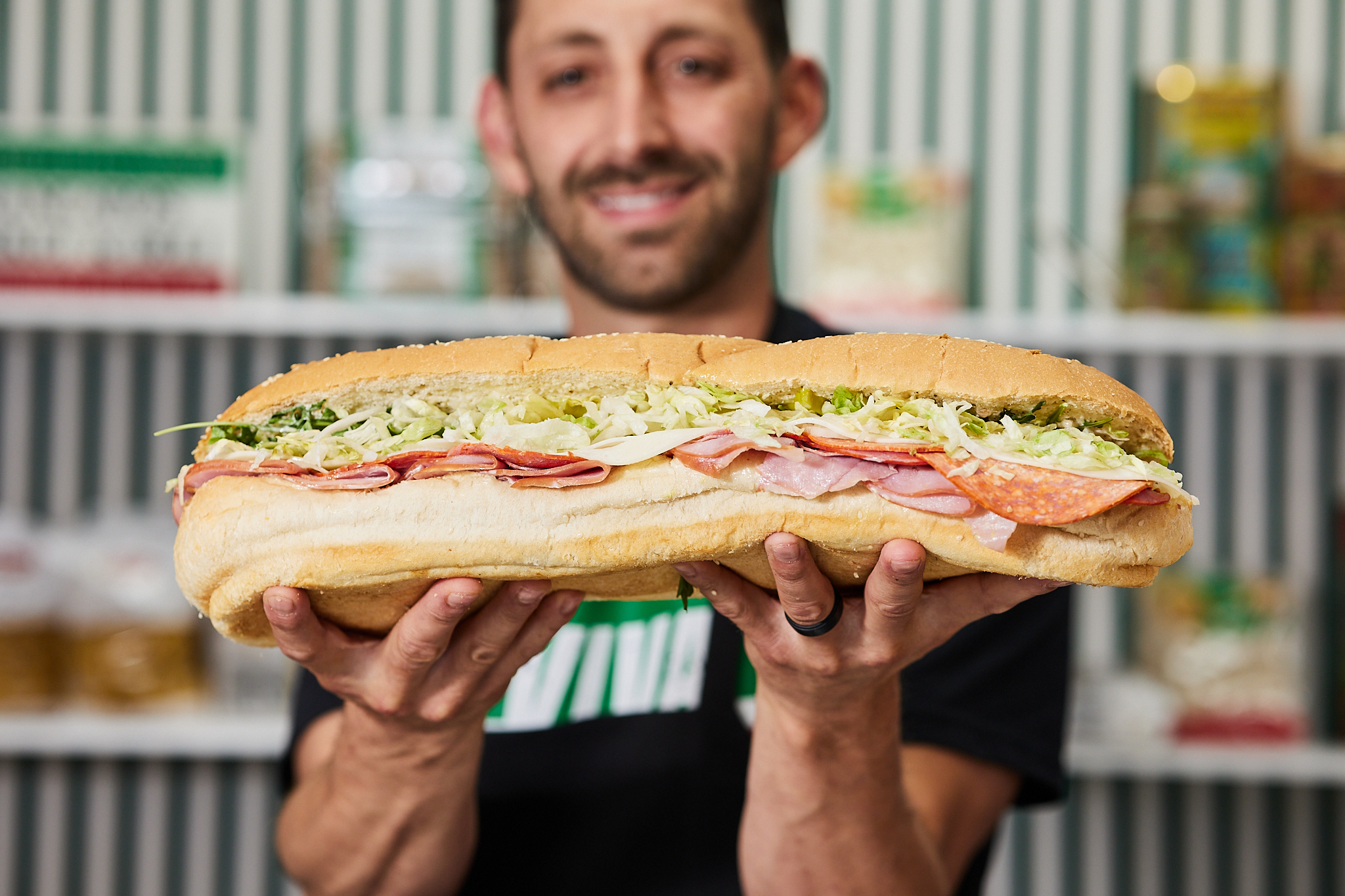Sixty-seven years ago, an eighteen-year-old Mennonite farm boy from a tiny Kansas town had a lake monster in his sights. Albert “Bert” Neufeld fired two shots from his hunting rifle in a vain attempt to bag Sinkhole Sam, the greatest monster legend Kansas has ever known.
There are multiple reports of a massive, snakelike creature swimming in the Big Sinkhole—that’s the official name according to the Kansas State Department of Transportation—a few miles outside of Inman, a tiny town northwest of Wichita. The legend began surfacing in the summer of 1952, the year before Neufeld took his shot. The creature was described as being between fifteen and thirty feet long, a wormy beast as big around as the tire from a 1951 REO Speedwagon.
At the time, Inman was home to approximately five hundred hard-working farmers, tradespeople and shop owners. Not a single one of them was quite sure what to make of the monster.
In 1952, a veteran Kansas newspaper columnist named Ernest Alva Dewey traveled to Inman to sort it all out. Dewey, whose writing career began as a publicist for a traveling circus, had a reputation for poking fun at local legends. He once attributed UFO sightings to an airborne Kansas dragon known as the “ball-tailed snickelhoopus.”
Dewey’s article was published by the Salina Journal Sunday before Thanksgiving. In it, he claimed he brought along a scientific sidekick by the name of Dr. Erasmus P. Quattlebaum. Don’t bother looking up Quattlebaum’s credentials. I assure you they are as real as Professor Marvel’s diploma in the Wizard of Oz.
Quattlebaum determined the sinkhole inhabitant was a “foopengerkle,” a critter known to inhabit subterranean Kansas caverns. That “fact” explains why such a large animal could exist in a body of water that only gets fifteen feet deep in the middle after a hard rain. The Big Sinkhole was merely Sam’s above-ground swimming pool.
Dewey concluded that fishermen and swimmers had nothing to worry about because Quattlelbaum’s research indicated foopengerkles were “terribly dumb” and very vegetarian.
Dewey’s spoof brought hordes of monster hunters to Section 27, a square mile of land just southeast of Inman. The northeast corner of Section 27 is where you will find the Big Sinkhole and, possibly, a vegetarian lake monster.
The Penner family has farmed this plot of land since 1874. In the late Mil Penner’s book Section 27: A Century on a Family Farm, he describes coming home from church one Sunday afternoon to a startling sight. Dozens of Desotos, Chevys and Nash Ramblers were parked at the edge of the Big Sinkhole.
Penner says folks were hoping to catch a glimpse of the thirty-foot foopengerkle spotted earlier in the week by a neighboring farmer. Penner noticed every single car window was rolled up just in case they got their wish. By this time, the locals had started calling Inman’s new roadside attraction Sinkhole Sam.
In 1953, when news of the prairie-locked sea serpent reached Kansas City, the Newspaper Enterprise Association dispatched reporter Mary Kay Flynn to the scene.

Flynn found numerous “responsible citizens” who described Sinkhole Sam as fifteen feet long with a fluted tail and a long fin on its back. Eyewitnesses also mentioned Sam’s big “non-snakelike” grin. Flynn hailed Sinkhole Sam as “Kansas’ answer to the Loch Ness Monster.”
Flynn’s article also includes the first account of Neufeld using Sinkhole Sam for target practice. Neufeld was sure he hit him, but another witness named George Regehr thought Sinkhole Sam evaded serious damage. On October 12, 1953, newspapers from Eugene, Oregon, to Panama City, Florida, picked up Flynn’s sensational story.
Was it all a hoax to boost tourism? Or were the locals merely having some fun with the city slickers? The only witnesses named in Flynn’s newspaper account were Neufeld and Regehr. Both men are dead.
“Mennonites are not exactly prone to exaggeration,” says Marci Penner, Mil’s daughter and the executive director of the Kansas Sampler Foundation in Inman.
Even though George Regehr’s daughter, Connie Newcome, says her father had the reputation of “town rogue,” the Neufeld family was not eager to promote the story. Dr. Edward Neufeld, a retired psychologist, was sixteen years old when his older brother’s Sinkhole Sam story became public. “Our family was embarrassed by the whole thing,” says Edward Neufeld, a retired psychologist living in the Kansas City area.
Bert Neufeld instead enriched himself over the years by sharing the story of Sinkhole Sam at bedtime and around campfires with younger members of his family. “Sinkhole Sam was always described as being longer than a man is tall, but my dad liked to say ‘the more people who saw Sinkhole Sam, the bigger he would get,’” says Brian Neufeld, Bert’s son.
I’m convinced Neufeld and Regehr stumbled upon something unusually large and saurian that day at the Big Sinkhole. To get a better idea of what they saw, I needed to consult an expert in cryptozoology, which is the study of unknown animals referred to as cryptids. So I called Loren Coleman, the world’s most respected cryptozoologist.
Coleman is the author of approximately forty books and thousands of articles on cryptids, ranging from the elusive Bigfoot to the wily chupacabra. Coleman is also the director of the International Cryptozoology Museum in Portland, Maine. Right off the bat, Coleman thought the description of Sinkhole Sam sounded similar to another cryptid: the Mongolian Death Worm.
I was relieved when Coleman said he was only referring to Sinkhole’s Sam’s snake-like dimensions—the thought of an acid-spitting worm from the Gobi Desert roaming around Kansas was a bit much. Besides, everybody knows Mongolian Death Worms top out at five feet long.
Next, we discussed the rich tradition of large, unknown animals swimming in Midwest waters from West Okoboji Lake in Iowa to the Missouri River. In the Inman area alone, I could find newspaper reports from 1912 and 1913 telling of Lake Inman bathers fearful of a turtle-like creature as big as a claw-footed bathtub.
In 2003, Coleman co-authored a book with Patrick Huyghe titled The Field Guide to Lake Monsters, Sea Serpents, and Other Denizens of the Deep. Although Sinkhole Sam didn’t make the book, there is an appendix entry for Kingman, Kansas, which is fifty miles south of Inman. That steered the discussion toward freakishly large snakes on the plains.
In the late 1960s, the citizens of Kingman organized a hunting party to track down a twenty-foot animal that was as big around as a man. The animal had reportedly devoured a calf it dragged into the Kingman County State Lake.
Did Sinkhole Sam tire of being shot at in Inman? Was vegetarianism just a phase? The Kingmanites suspected they were dealing with a giant snake. There’s only one problem: The longest snake native to Kansas is half the size of Sink-hole Sam and the State Lake snake.
According to Travis Taggart, the president and executive director of the Center for North American Herpetology, the gopher snake is common in the Inman area. It is the longest native Kansas snake, reaching lengths of approximately eighty-nine inches.
Taggart says the gopher snake is a likely candidate for Sinkhole Sam because it doesn’t mind getting into the water. “Snakes are difficult enough to size-up when they’re coiled, but even more so when they are moving or swimming. And of course, the bigger the snake, the better the story,” Taggart says.
Or, Taggart says, people in Inman could have encountered a boa constrictor or python released into the wild by an exotic pet owner. It’s difficult to imagine an exotic pet owner living anywhere near Inman in the early 1950s, but anything is possible. Even so, a Mennonite farm boy lighting up a fifteen-foot python in a Kansas sinkhole is still a hell of a good monster story.
Until some lucky shot bags a body, we may never know whether Sinkhole Sam was a giant snake or something more akin to the Loch Ness monster. But that might not matter. “Whether the story of Sinkhole Sam is true or not, I know one thing for certain,” Penner says. “The legend is real.”





